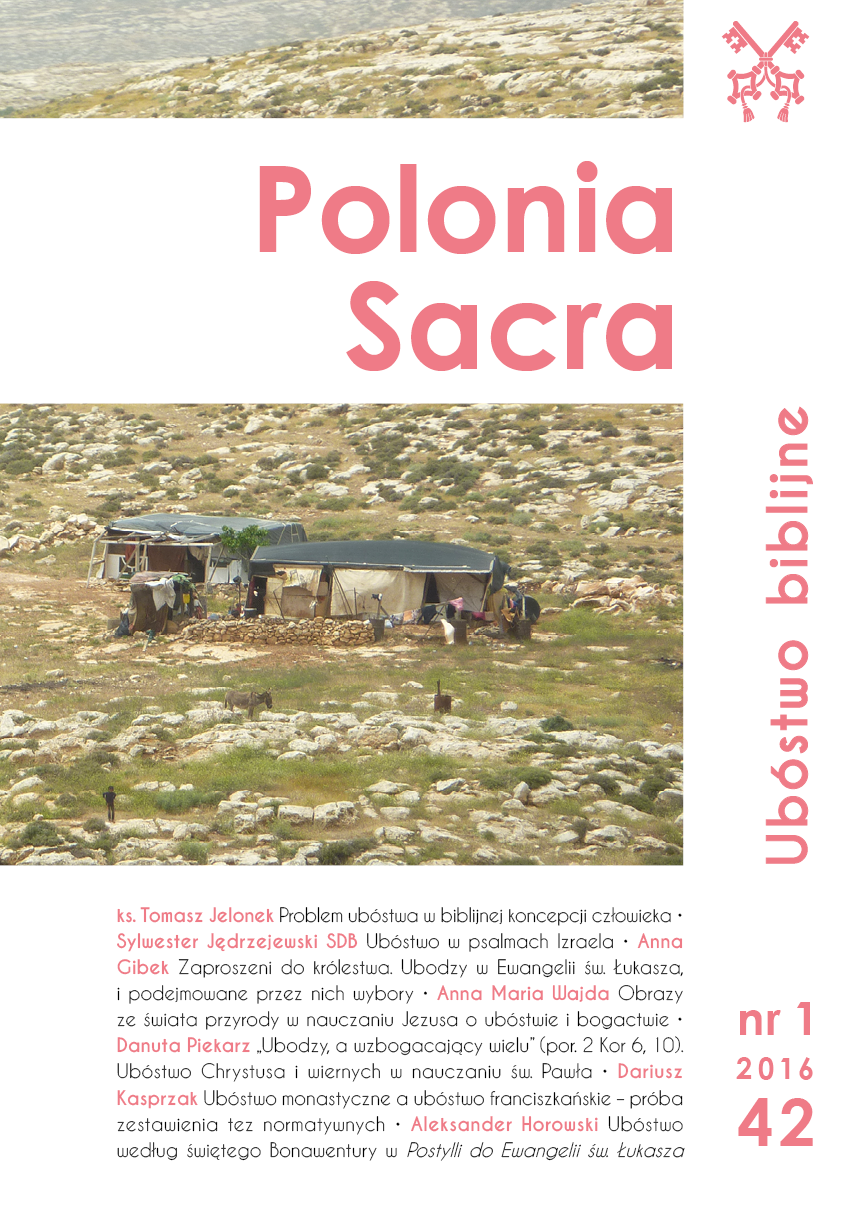Images from the natural world in the teaching of Jesus about poverty and wealth
DOI:
https://doi.org/10.15633/ps.1592Keywords:
poverty, wealth, Jesus, fauna, floraAbstract
The presence of numerous animals and plants’ names in the New Testament, often accompanied by descriptions of their characteristics, is caused by the fact that the Jesus often used the language of imagery to present the revealed truths to their contemporary listeners. At the same time, it is essential to emphasize the fact that this rich natural world is for the Master of Nazareth just a tool used to translate God’s address into human language. For this reason, the knowledge of the animal symbolism in the Holy Writ allows for the accurate understanding of the pericope. In the New Testament we can also come across descriptions in which Christ refers to animal lives in order to illustrate his teachings about poverty and wealth. The following words of Jesus can serve as an example: “Foxes have dens and birds of the sky have nests, but the Son of Man has nowhere to rest his head” (Mt 8:20). Jesus also reached for bird images in his teachings about these issues: “Look at the birds in the sky; they do not sow or reap, they gather nothing into barns, yet your heavenly Father feeds them” (Mt 6:26).These words clearly show that those who listened to Jesus had to be familiar with those animals, especially with the way they fed and built their nests. The Jesus description of clothes moths shows the insignificance of earthly riches. The destruction of clothes by the moth in the Bible lands was not an occasional or incidental occurrence, but something which, in the given time, was bound to happen. As recorded in the words of Christ: “Lay not up for yourselves treasures upon earth, where moth and rust doth corrupt, and where thieves break through and steal” (Mt 6:19 and Lu 12:33).References
Anonymus, Atlas biblijny, Warszawa 1990.
Cansdale G., Animals of Bible lands, Sydney–Toronto–Auckland–Cape Town 1970.
Chouraqui A., Życie codzienne ludzi Biblii, przekł. L. Kossobudzki, Warszawa 1995.
Daniel-Rops H., Życie w Palestynie w czasach Chrystusa, przekł. J. Lasocka, Warszawa 2001.
Encyklopedia zwierząt. Ssaki, red. A. Pressley, tłum. E. Świątkowska, P. Świątkowski, Warszawa 1991.
Ferguson W.W., The mammals of Israel, Jerusalem 2002.
France P., An encyclopedia of Bible animals, Tel Aviv 1986.
Heide M., The domestication of the camel : biological, archaeological and inscriptional evidence from Mesopotamia, Egypt, Israel and Arabia, and literary evidence from the Hebrew Bible, „Ugarit-Forschungen, Internationales Jahrbuch für die Altertumskunde Syrien-Palästinas”, Bd 42 (2010), s. 331–382.
Jelonek T, Hospicjum św. Aleksandra newskiego, „Ziemia Święta”, nr 1 (77) 2014, s. 22–25.
Kawollek W., Falk H., Podróż po biblijnych ogrodach. Informacje o roślinach oraz wskazówki dotyczące ich uprawy, tłum. K. Kwiecień, Poznań 2005.
Kudasiewicz J., Jezus historii a Chrystus wiary, Lublin 1987.
Leksykon zwierząt od A do Ż, red. B. Zasieczna, Warszawa 1992.
Lurker M., Słownik obrazów i symboli biblijnych, tłum. K. Romaniuk, Poznań 1989.
Mickiewicz F., Ewangelia według św. Łukasza, rozdziały 1–11. Wstęp. Przekład z oryginału. Komentarz, cz. 1, Częstochowa 2011 (Nowy Komentarz Biblijny).
Mickiewicz F., Ewangelia według św. Łukasza, rozdziały 12–24. Wstęp. Przekład z oryginału. Komentarz, cz. 2, Częstochowa 2012 (Nowy Komentarz Biblijny).
Paciorek A., Ewangelia według św. Mateusza, rozdziały 1–13. Wstęp. Przekład z oryginału. Komentarz, cz. 1 poprawiona, Częstochowa 2005 (Nowy Komentarz Biblijny).
Paz U., Eshbol Y., Birds in the land of the Bible, Herzila [b.r.w.].
Pismo Święte Starego i Nowego Testamentu w przekładzie z języków oryginalnych, opracował Zespół Biblistów Polskich z inicjatywy Benedyktynów Tynieckich, Poznań 2000.
Sandner H., Owady. Zwierzęta świata, Warszawa 1989.
Słownik tła Biblii, red. J. I. Packer, M. C. Tenney, przekł. Z. Kościuk, Warszawa 2007.
Szczepanowicz B., Mrozek A., Atlas zwierząt biblijnych. Miejsce w Biblii i symbolika, Kraków 2007.
Szczepanowicz B., Wesołowska-Kowalska B., Moda w Biblii. Odzież, obuwie, nakrycia głowy, fryzury oraz kosmetyki i ozdoby, Kraków 2011.
Świat zwierząt, red. H. Grabarczyk, Warszawa 1986.
Świat zwierząt, red. L. Korbel, Warszawa 1989.
Trudne fragmenty Biblii, red. Kaiser W.C. Jr i in., tłum. L. Bigaj, Warszawa 2011.
Wajda A. M., Szkarłat i purpura w Biblii, „Studia Leopoliensia” 5 (2012), s. 123–130.
Wąsowski A., Biblijno-teologiczny wymiar bramy, Kraków 2014.
Wielki słownik frazeologiczny PWN z przysłowiami, red. A. Kłosińska, E. Sobol, A. Stankiewicz, Warszawa 2005.
Włodarczyk Z., Rośliny biblijne. Leksykon, Kraków 2011.
Downloads
Published
Issue
Section
License
Authors who publish with this journal agree to the following terms:
- Authors retain the copyright and full publishing rights without restrictions, and grant the journal right of first publication with the work simultaneously licensed under a Creative Commons Attribution 4.0 International License that allows others to share the work with an acknowledgement of the work's authorship and initial publication in this journal.
- Authors are able to enter into separate, additional contractual arrangements for the non-exclusive distribution of the journal's published version of the work (e.g., post it to an institutional repository or publish it in a book), with an acknowledgement of its initial publication in this journal.
- Authors are permitted and encouraged to post their work online (e.g., in institutional repositories or on their website) prior to and during the submission process, as it can lead to productive exchanges, as well as earlier and greater citation of published work (See The Effect of Open Access).

